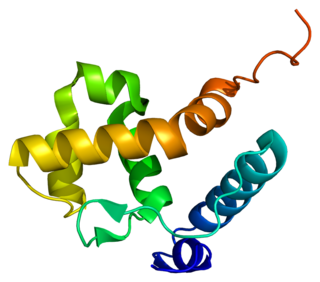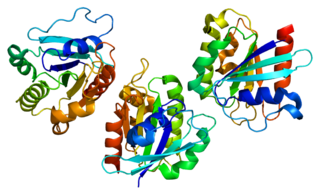
FMR1 is a human gene that codes for a protein called fragile X messenger ribonucleoprotein, or FMRP. This protein, most commonly found in the brain, is essential for normal cognitive development and female reproductive function. Mutations of this gene can lead to fragile X syndrome, intellectual disability, premature ovarian failure, autism, Parkinson's disease, developmental delays and other cognitive deficits. The FMR1 premutation is associated with a wide spectrum of clinical phenotypes that affect more than two million people worldwide.

Integral membrane protein GPR155, also known as G protein-coupled receptor 155, is a protein that in humans is encoded by the GPR155 gene. Mutations in this gene may be associated with autism.

Fragile X mental retardation syndrome-related protein 1 is a protein that in humans is encoded by the FXR1 gene.

Trinucleotide repeat-containing gene 6A protein is a protein that in humans is encoded by the TNRC6A gene.

AT-rich interactive domain-containing protein 1B is a protein that in humans is encoded by the ARID1B gene. ARID1B is a component of the human SWI/SNF chromatin remodeling complex.

Myosin-binding protein C, slow-type is a protein that in humans is encoded by the MYBPC1 gene.

TRIO and F-actin-binding protein is a protein that in humans is encoded by the TRIOBP gene.

E1A-binding protein p400 is a protein that in humans is encoded by the EP400 gene.

ADP-ribosylation factor-like protein 6 is a protein that in humans is encoded by the ARL6 gene.

BAI1-associated protein 3 is a protein that in humans is encoded by the BAIAP3 gene.

PERQ amino acid-rich with GYF domain-containing protein 2 is a protein that in humans is encoded by the GIGYF2 gene.

Nuclear fragile X mental retardation-interacting protein 2 is a protein that in humans is encoded by the NUFIP2 gene.

Trinucleotide repeat-containing gene 6B protein is a protein that in humans is encoded by the TNRC6B gene.

Zinc finger protein 346 is a protein that in humans is encoded by the ZNF346 gene.

Cysteine-rich secretory protein LCCL domain-containing 2 is a cysteine-rich secretory protein that in humans is encoded by the CRISPLD2 gene.

Transmembrane and TPR repeat-containing protein 2 is a protein that in humans is encoded by the TMTC2 gene.

WD repeat-containing protein 24 is a protein that in humans is encoded by the WDR24 gene.

ATP-binding cassette sub-family A member 9 is a protein that in humans is encoded by the ABCA9 gene.

Zinc finger protein 300 is a protein that in humans is encoded by the ZNF300 gene. The protein encoded by this gene is a C2H2-type zinc finger DNA binding protein and a likely transcription factor.
David L. Nelson is an American human geneticist, currently an associate director at the Intellectual and Developmental Disabilities Research Center (1995), and professor at the Department of Molecular and Human Genetics at Baylor College of Medicine BCM since 1999. Since 2018, he is the director at the Cancer and Cell Biology Ph.D program, and the director of Integrative Molecular and Biomedical Sciences Ph.D since 2015 at BCM.














